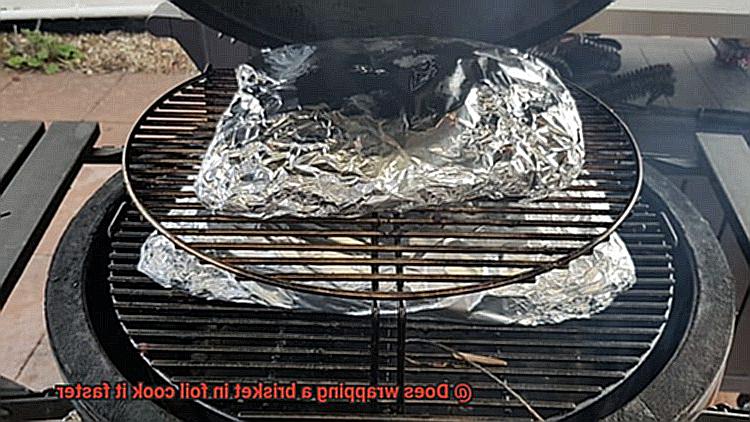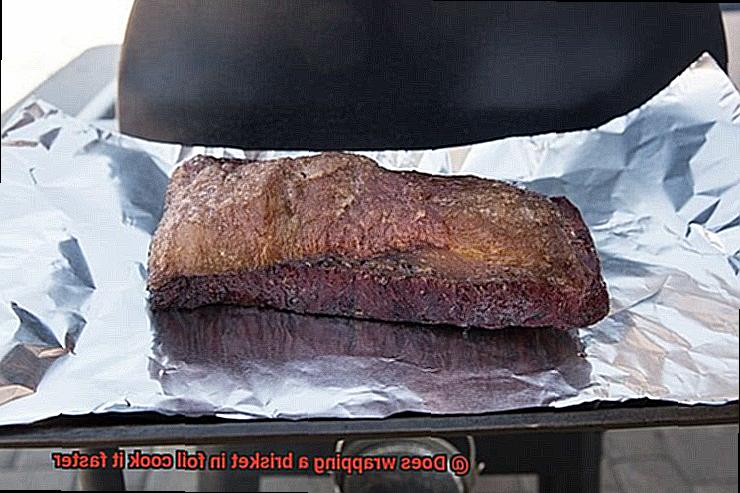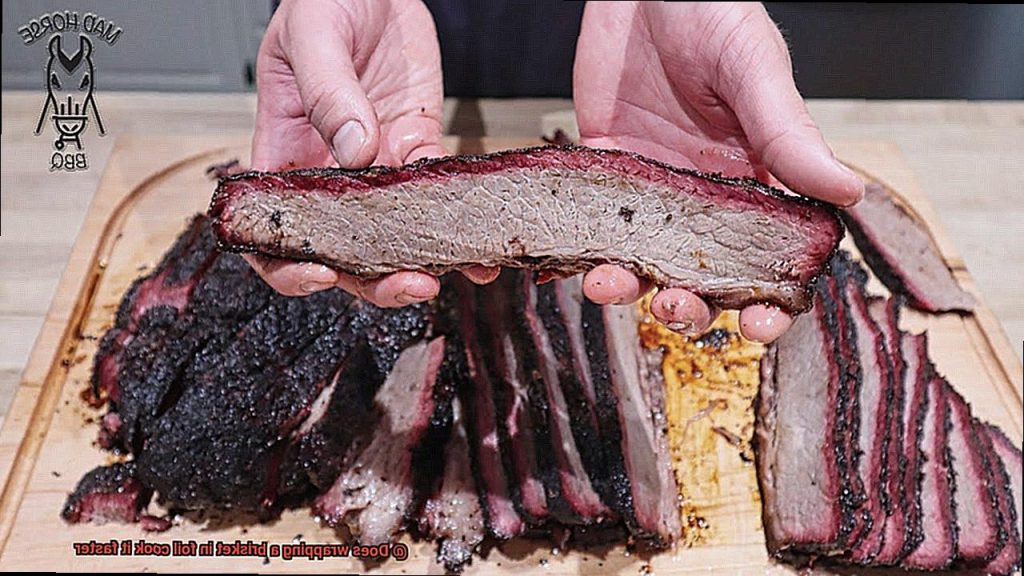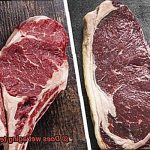Are you a meat aficionado who knows the importance of a perfectly cooked brisket? The kind that’s juicy, tender, and bursting with flavor? Then you’re probably familiar with the ongoing debate over the best cooking methods. And one of the most contentious questions is whether wrapping your brisket in foil will speed up the cooking process. Some swear by it, while others remain skeptical.
So, does wrapping a brisket in foil really cook it faster? Well, it’s not a simple yes or no answer. Wrapping your brisket in foil or butcher paper can indeed help it cook faster by speeding up the rendering process. That’s when the fat and collagen break down and turn into delicious melted gelatin. But here’s the catch: The higher the temperature, the faster the juice evaporates, which can lead to a dry and tough brisket.
While wrapping your brisket in foil can reduce cooking time, it’s not foolproof. Variables such as size, cooking temperature, and humidity levels of your cooking environment are all crucial factors that can affect both cooking time and outcome. But don’t worry – we’ve got you covered. Keep reading to learn more about the pros and cons of wrapping your brisket in foil and other methods for achieving that perfect brisket every time.
Contents
What is Brisket?
Brisket is a mouthwatering cut of meat that hails from the breast section of a cow. Its tough and chewy texture makes it a challenge to cook, but with patience and the right techniques, it transforms into a succulent and flavorful delicacy.
Composed of two parts, the point and the flat, brisket boasts distinct characteristics. The point is fatty and savory, while the flat is leaner and less flavorful.
Barbecue enthusiasts adore brisket for its rich beefy flavor that pairs exceptionally well with smoky and savory seasonings. Smoked or slow-roasted for hours on end, it becomes tender and juicy, infused with the delightful aroma of wood smoke. It is this versatility that has made brisket an essential ingredient in many dishes such as stews, soups, and sandwiches.
Many cooks wonder whether wrapping brisket in foil will speed up the cooking process. While it does indeed do so by trapping heat and moisture inside, there are downsides to this method. Foil wrapping can cause the meat to steam rather than smoke, which may affect its flavor. It can also prevent the development of a crispy bark on the outside, which some grillers prefer.

Benefits of Wrapping Brisket in Foil
As an expert in all things barbecue, I’m here to tell you about the benefits of this technique.
First and foremost, wrapping brisket in foil can speed up the cooking process. When you wrap the meat in foil, you create a sealed environment that traps heat and moisture around it. This can accelerate the cooking process, reducing the overall cooking time. So if you’re short on time but still want to enjoy a delicious brisket, wrapping it in foil is the way to go.
But that’s not all – wrapping brisket in foil also helps to keep the meat moist and tender. Without proper care, brisket can easily dry out and become tough. However, this technique helps to trap in moisture from the meat, resulting in a juicier and more tender finished product. Think of it as a cozy blanket for your brisket that keeps it warm and moist.
What’s more, wrapping brisket in foil allows you to infuse even more flavor into your meat. By adding additional seasonings or liquids to the foil packet, you can enhance the flavor profile of your brisket. This means that every bite is bursting with deliciousness.
Of course, it’s worth noting that wrapping brisket in foil may not be necessary or desirable for every cook or recipe. It’s important to experiment with different techniques and find what works best for your individual needs and preferences. But if you’re looking for a way to cook faster while retaining moisture and enhancing flavor, wrapping your brisket in foil is definitely worth trying.
In summary, the benefits of wrapping your brisket in foil include:
- Faster cooking times
- Increased moisture retention
- Enhanced flavor
Drawbacks of Wrapping Brisket in Foil
When it comes to cooking brisket, there are few things more tempting than wrapping it in foil. The idea of a perfectly moist and tender brisket cooked in half the time is undeniably alluring. However, before you break out the aluminum foil, it’s important to understand the potential drawbacks of this method.
Perhaps the biggest issue with wrapping brisket in foil is that it can cause the meat to steam. This can lead to a loss of flavor and texture, resulting in a mushy consistency that lacks the signature crispy exterior that brisket enthusiasts crave. Additionally, the foil can trap too much moisture, which can result in a soggy bark – definitely not what you want if you’re hoping for a juicy brisket with a satisfying crunch.
Another concern is that wrapping the brisket in foil can limit the amount of smoke flavor that permeates the meat. This can be problematic for those who are looking for a pronounced smoky flavor in their brisket. When the meat is wrapped tightly, it can prevent smoke from penetrating deeply into the meat and imparting its signature flavor.
Finally, wrapping brisket in foil can make it difficult to achieve that coveted bark – the crispy exterior of the meat that forms during cooking and is highly prized by BBQ enthusiasts. Since moisture is trapped inside the foil, it can be challenging to get that perfect outer layer.
While there are certainly benefits to wrapping brisket in foil – such as speeding up cooking times and retaining moisture – it’s important to weigh these against the potential drawbacks. If you’re after that perfect bark and smoky flavor, you might want to experiment with alternative cooking techniques such as using butcher paper or leaving the brisket unwrapped for part of the cooking process.
How to Wrap a Brisket in Foil
Wrapping it in foil can be your solution. Here’s a step-by-step guide on how to wrap a brisket in foil for faster cooking times:
Choose Heavy-Duty Aluminum Foil
Quality matters, so make sure to use heavy-duty aluminum foil that’s designed for high-temperature cooking. This will prevent the foil from ripping or breaking during the cooking process.
Seal the Foil Tightly
The key to trapping heat and moisture is by tightly sealing the foil around the brisket. Create a sealed environment that allows the meat to cook in its own juices.
Add Liquid for Moisture
Keep your meat moist and tender by adding liquid such as beef broth or apple juice to the foil. This will help create a moist environment without making the brisket too soggy.
Timing is Everything
Wrapping your brisket too early in the cooking process can slow down cooking times by creating a barrier that slows heat transfer. Wait until the internal temperature of your brisket reaches 160°F before wrapping it in foil.
Personal Preferences Matter
Ultimately, whether or not to wrap your brisket in foil comes down to personal preference. Some grill masters prefer not to use foil at all, while others swear by it for achieving perfectly cooked brisket.
Tips for Cooking a Brisket with Foil
Cooking a brisket with foil is a popular method that can yield delicious results, but it also has its pros and cons. Here are five subtopics to consider when deciding whether or not to use foil:
Moisture retention:
One of the main benefits of using foil is that it helps retain moisture, which is crucial when cooking a tough cut of meat like brisket. Wrapping the brisket tightly in foil creates a steamy environment that helps break down connective tissue and keeps the meat tender and juicy.
Seasoning:

Seasoning the brisket before wrapping it in foil is highly recommended. This step allows the flavors to penetrate deeply into the meat and creates a flavorful crust on the outside. A dry rub or marinade works well and can enhance the overall taste of the dish.
Crispy bark:
While using foil can help retain moisture, it can also prevent the formation of a crispy bark on the outside of the brisket. If you prefer a crunchy texture, removing the foil during the last hour of cooking can help achieve this result.
Steamed flavor:
Some people feel that using foil can result in a slightly “steamed” flavor, which may not be desirable if you’re looking for a smoky taste. However, this can be remedied by adding wood chips to your grill or smoker to infuse the meat with a smoky flavor.
Cooking time:
Using foil can shorten the cooking time by trapping heat and moisture around the meat. However, it’s important to note that cooking times will vary depending on factors such as the size of your brisket and your desired level of doneness. It’s important to monitor your brisket closely and adjust cooking times accordingly.
Alternatives to Wrapping a Brisket in Foil
The debate over whether to wrap a brisket in foil is a contentious one among pitmasters. However, for those who prefer not to use foil due to environmental concerns or taste preferences, there are alternative methods that can achieve similar results.
One option is to use butcher paper, which is a non-waxed paper that can withstand high temperatures and moisture. Butcher paper allows the meat to breathe while still retaining moisture, resulting in a tender and juicy brisket. Furthermore, it is biodegradable and compostable, making it an environmentally friendly choice.
Another method is to use a roasting pan with a lid. Placing the brisket in the pan and covering it with the lid traps moisture and creates a steamy environment that tenderizes the meat. This approach eliminates the need for wrapping the brisket in foil, making it a more sustainable choice.
Lastly, some pitmasters swear by not wrapping their brisket at all. This technique involves cooking the brisket low and slow without any covering. While it may result in a slightly drier bark, it allows for maximum smoke penetration and a more pronounced smoky flavor.
_Ldg73DumjI” >
Conclusion
Brisket – a cut of meat that requires patience and expertise to cook perfectly. Composed of two parts – the point and flat – it boasts distinct characteristics that make it a challenge to cook. But, when done right, it’s a mouthwatering masterpiece that barbecue enthusiasts adore for its rich beefy flavor.
One question that often arises when cooking brisket is whether wrapping it in foil can speed up the process. The answer is yes – wrapping your brisket in foil can indeed trap heat and moisture around the meat, resulting in a tender and juicy finished product. However, this method has potential drawbacks such as steaming the meat instead of smoking it, limiting smoke flavor penetration, and preventing the formation of a crispy bark on the outside.
To wrap your brisket in foil for faster cooking times, choose heavy-duty aluminum foil designed for high-temperature cooking. Seal it tightly around the meat, add liquid for moisture retention, wait until internal temperature reaches 160°F before wrapping it in foil, and experiment with different techniques based on personal preferences.
But ultimately, whether or not to wrap your brisket in foil comes down to personal preference and experimentation with alternative methods such as using butcher paper or leaving the brisket unwrapped for part of the cooking process.






